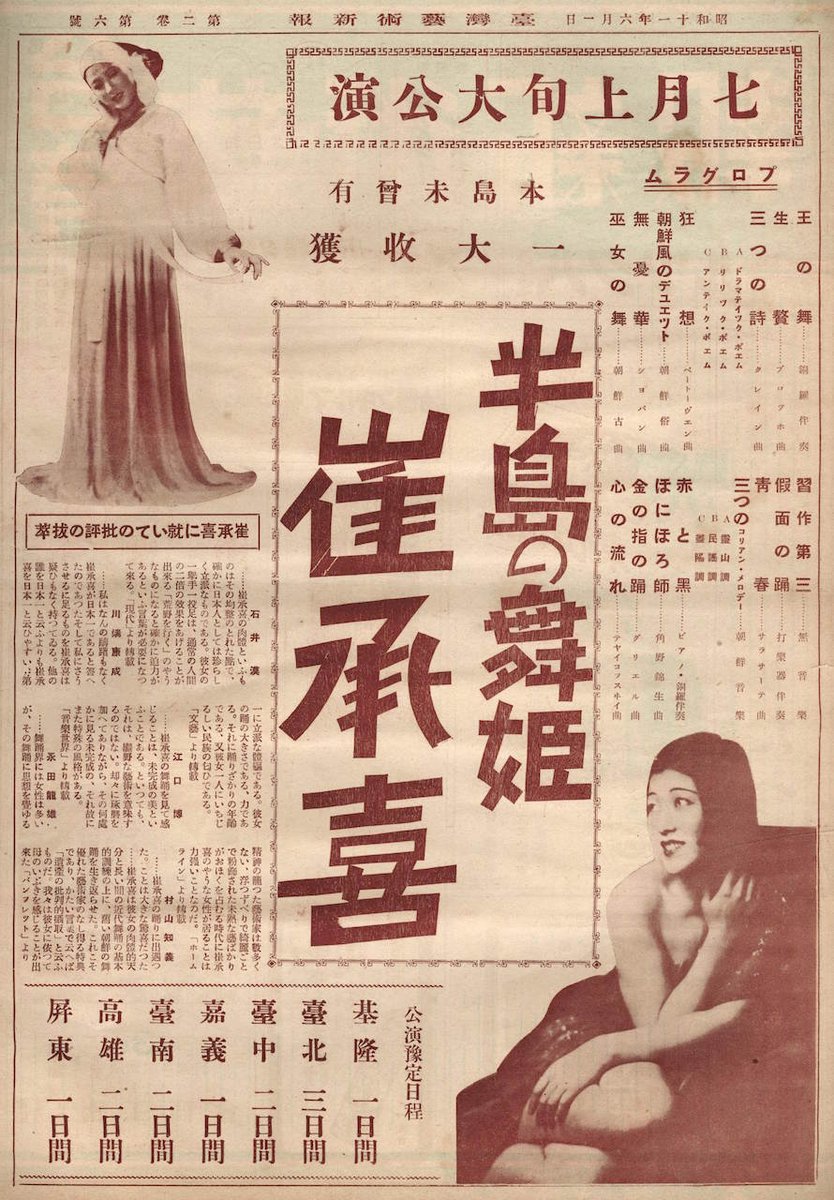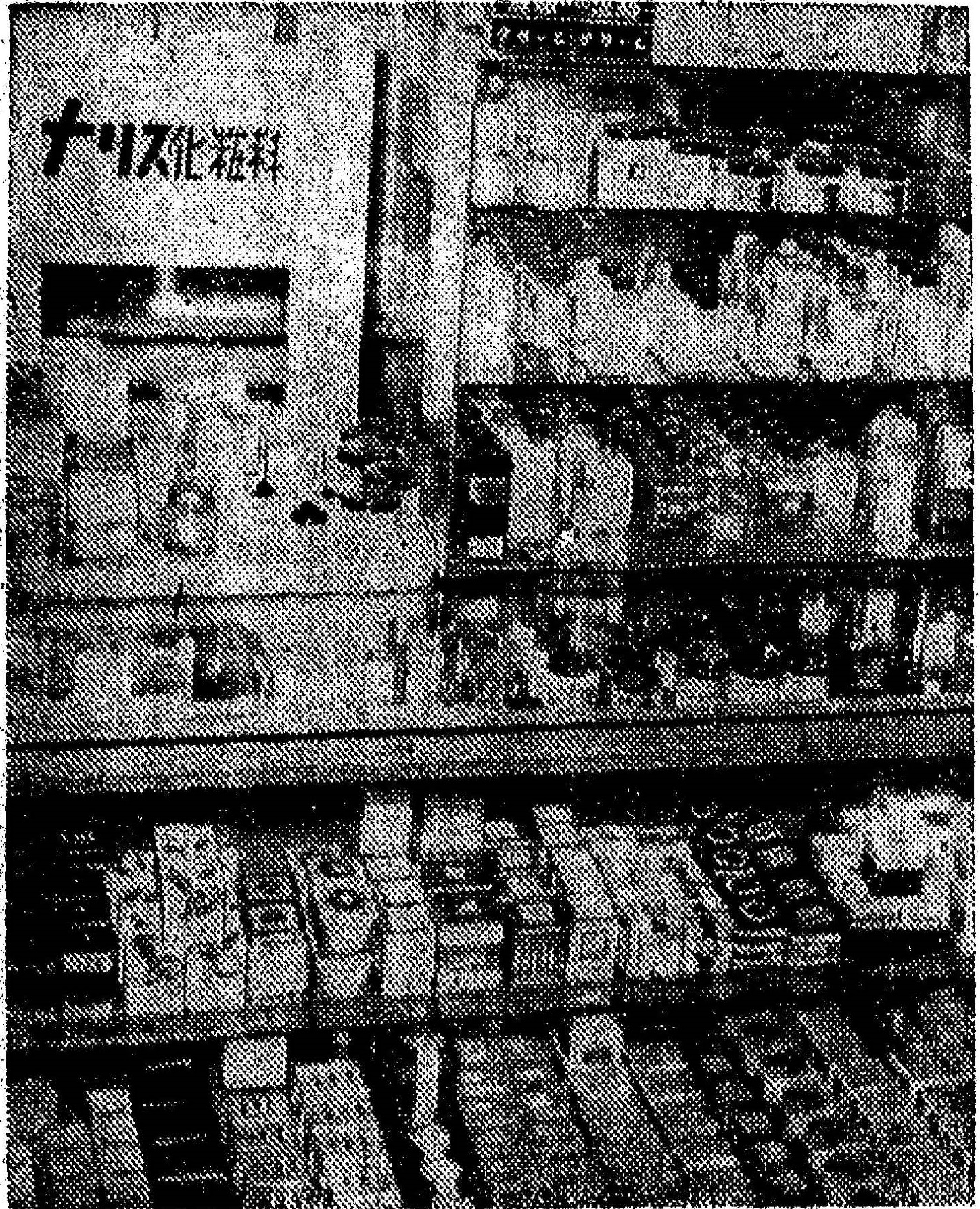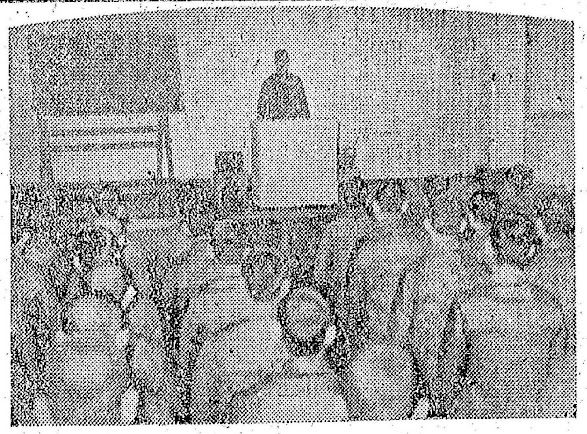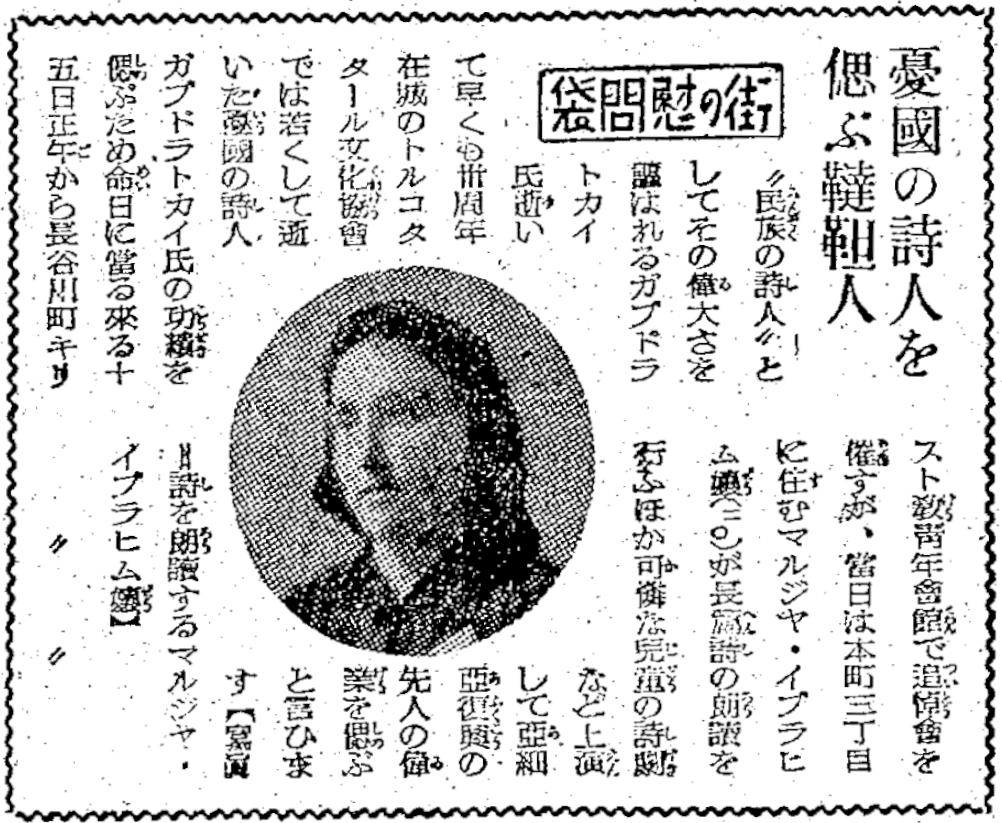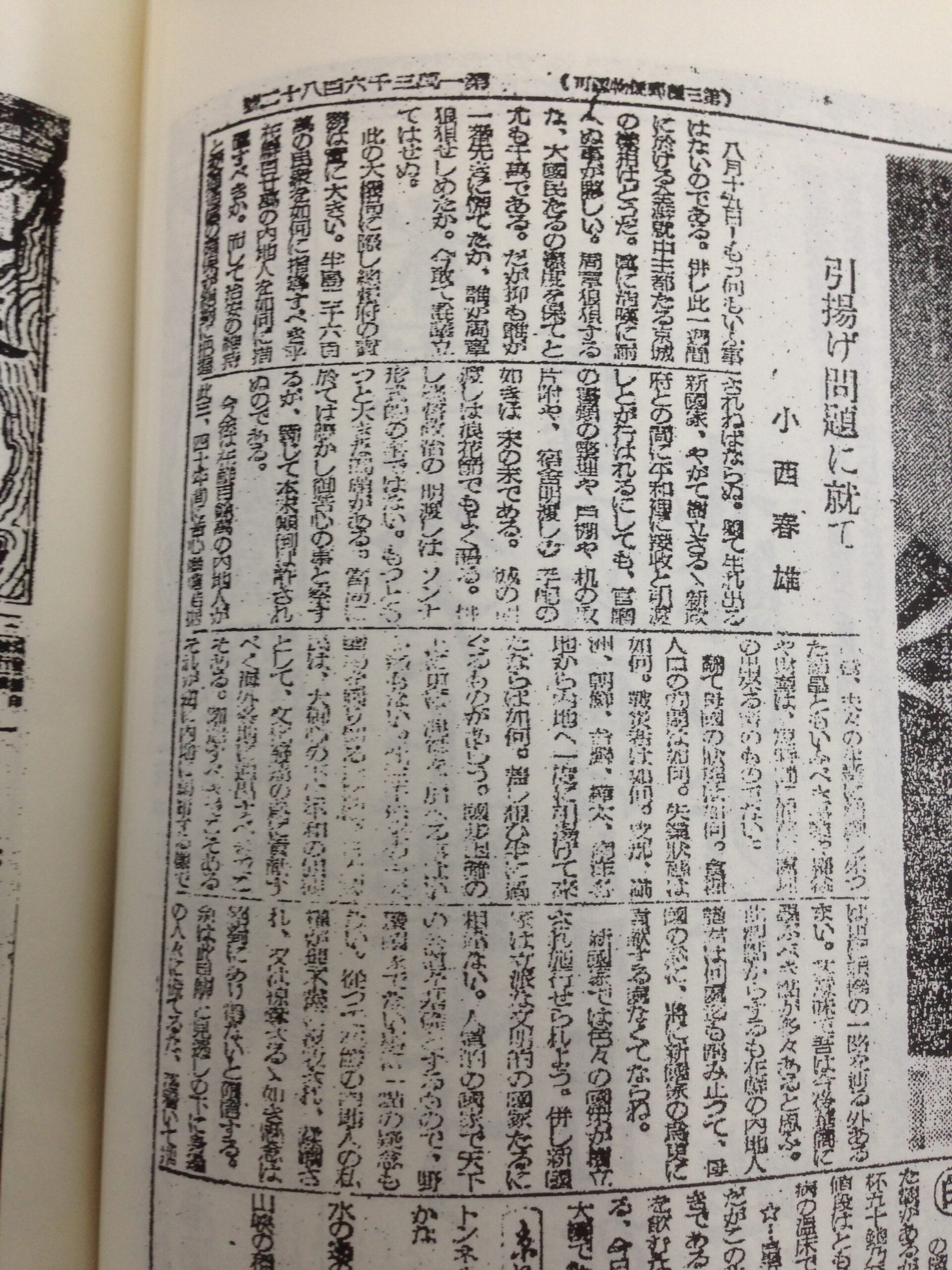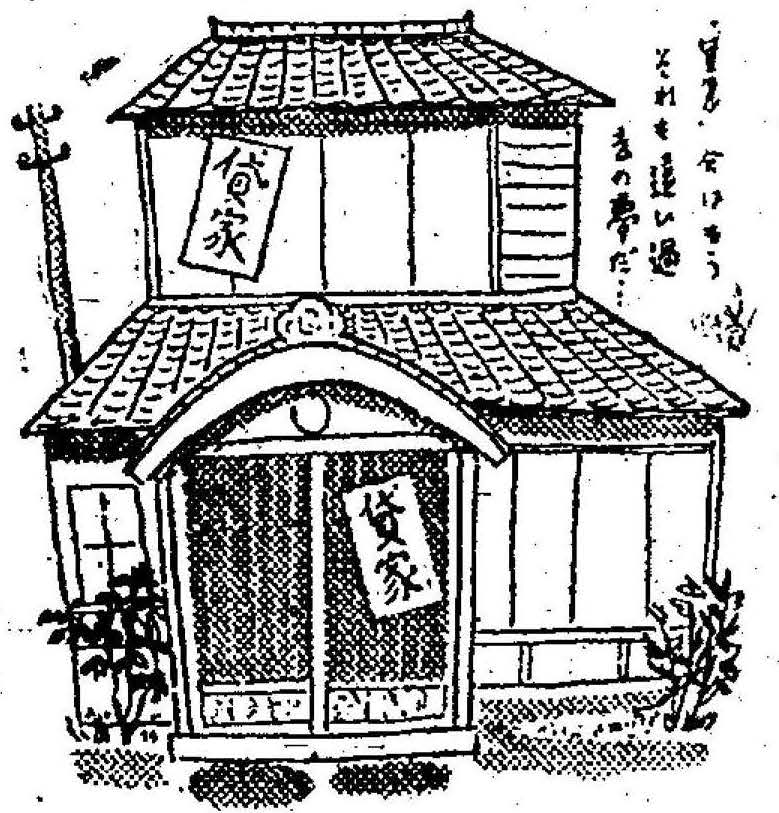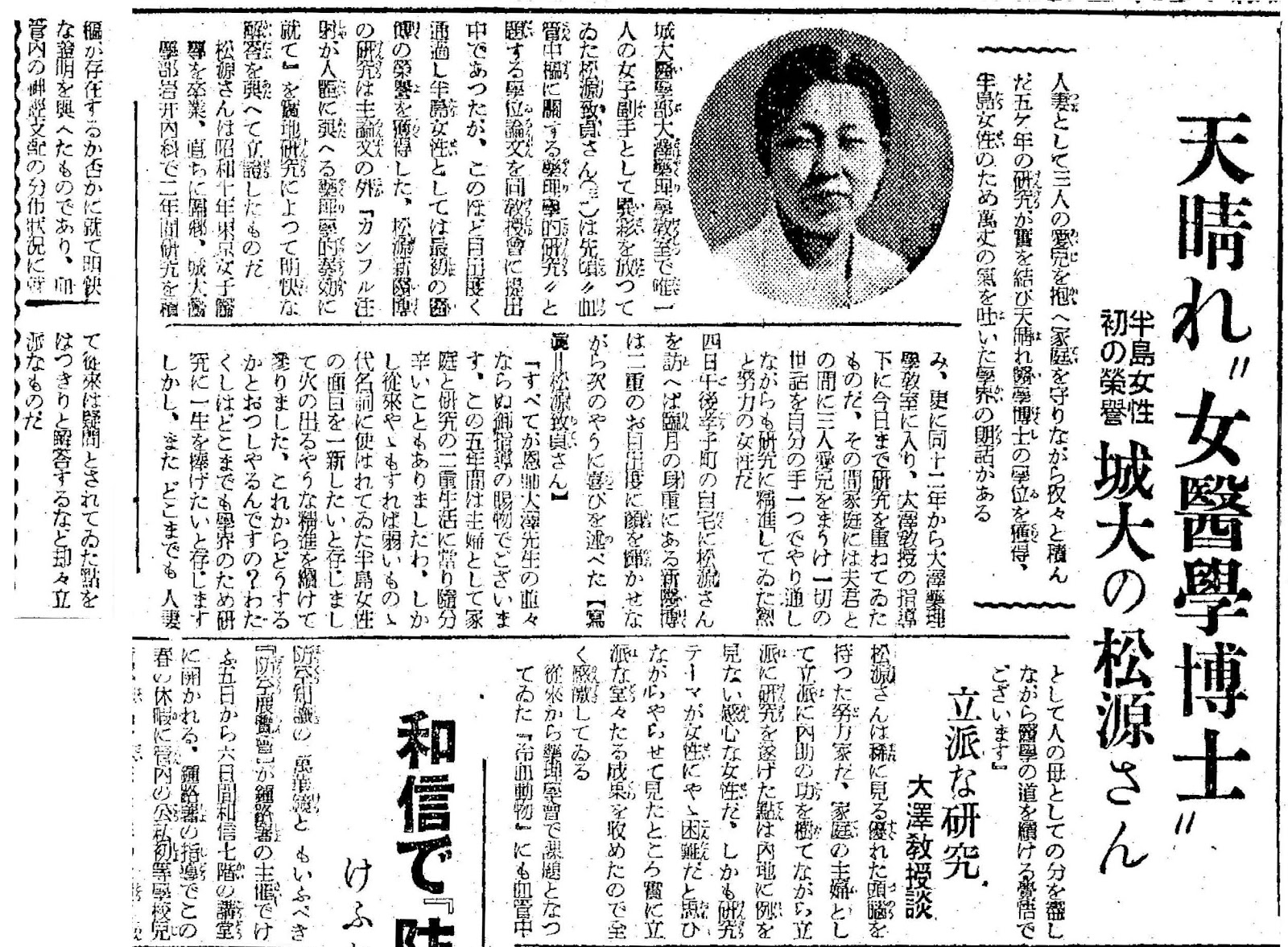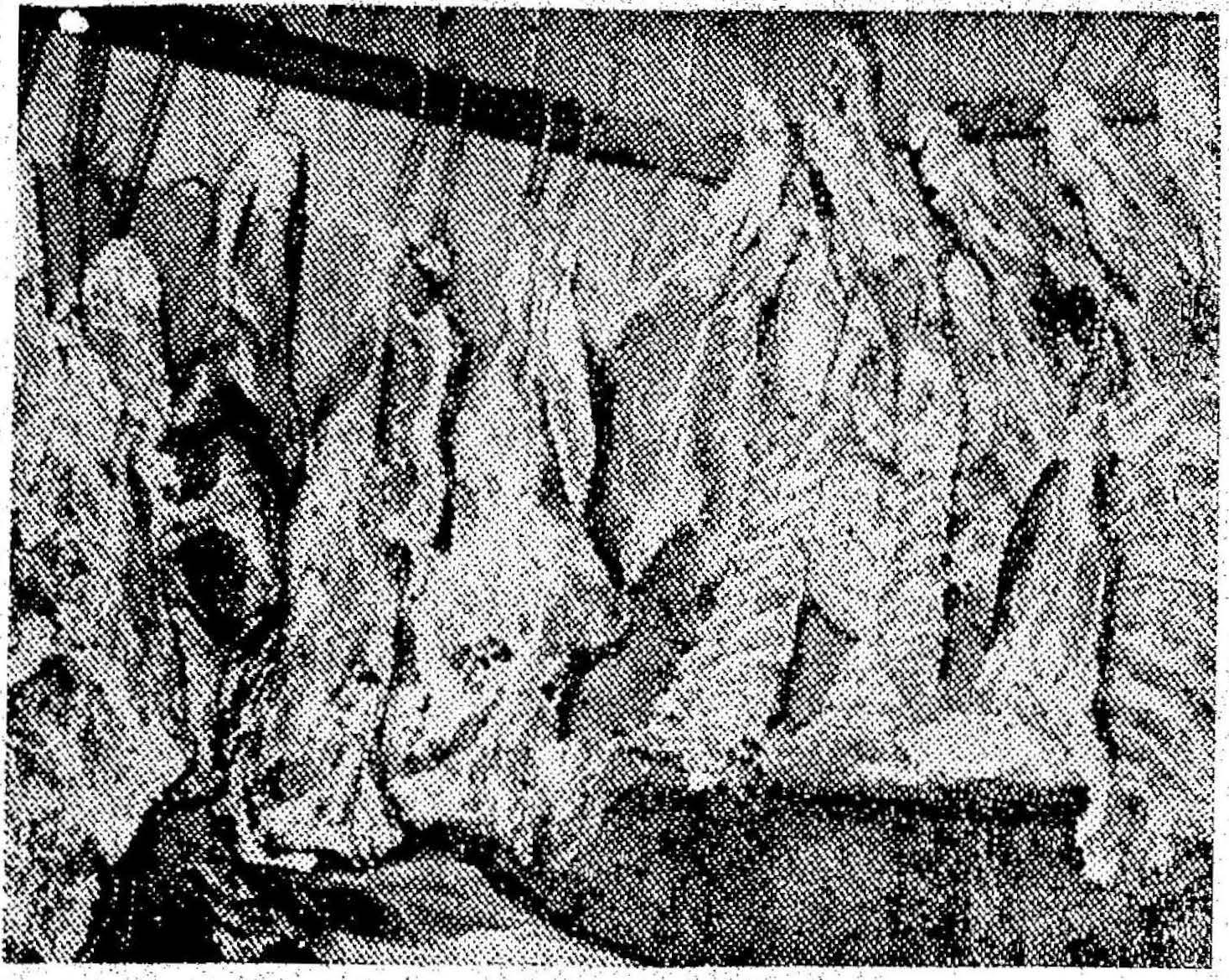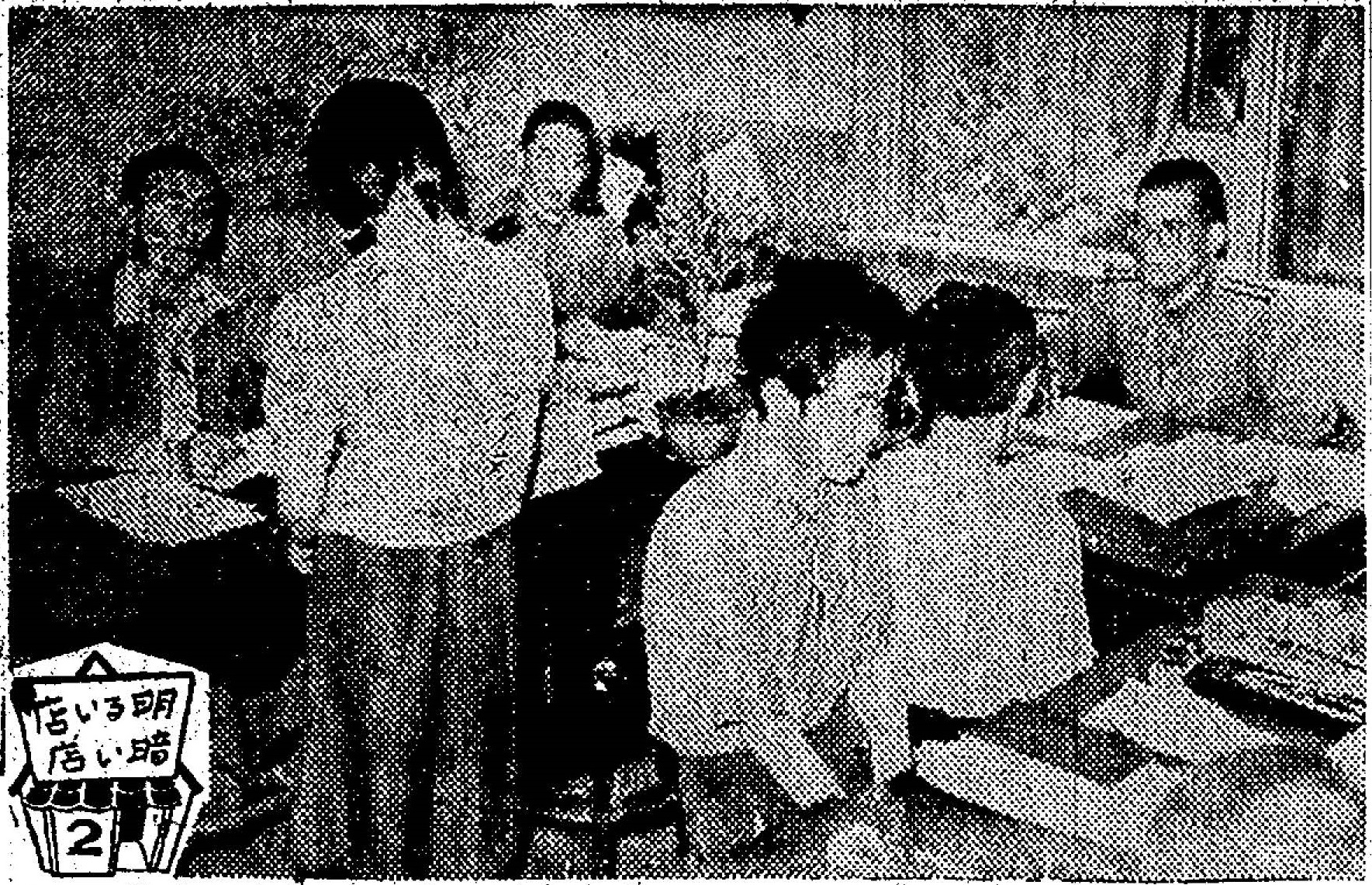Vegetable rationing in 1943 Seoul was measly (~200 grams a day per person), monotonous (mostly bok choy and daikon radish), and controlled by Patriotic Groups, the local arm of the ruling party of Japan-colonized Korea – severe shortages of carrots, taro roots, yams, all sold on the black market
This article talks about vegetable shortages in Korea in December 1943, two years into an all-out war against the US. In response to widespread vegetable shortages and the proliferation of black markets, colonial authorities implemented a rationing system for vegetables, where vegetable supplies were funneled into a centralized distribution point, and then distributed to non-households (including restaurants) and households, where each person was allotted a measly vegetable ration of about 200 grams per day. The situation with eggs, meat, and fish was also dire. Not surprisingly, ordinary citizens were encouraged to grow their own food and forage for edible wild plants.
Patriotic Groups (local neighborhood cells) were in charge of vegetable rationing. The Korean Federation of National Power (国民総力朝鮮連盟, 국민총력조선연맹), the single ruling party of Japan-colonized Korea, organized these patriotic groups (愛国班, aikoku-han or aeguk-ban) to control the colonized population at the local level. Members of the cells would report each other for infractions, perhaps for breaking rules like speaking Korean in public. They would also organize ‘patriotic’ activities like worship rituals at Shinto shrines, mandatory Shinto prayer sessions twice a day, etc. Food rationing was often withheld when a cell member refused to participate in Shinto worship at shrines. Similar local cell organizations still exist in countries like Cuba and North Korea.
(Translation)
Gyeongseong Daily (Keijo Nippo) December 18, 1943
Selfishness leading to rotting vegetables
Dry Storage in Preparation for Winter
Tomorrow’s posture to win through to victory
A Focus on Eating Habits (2) (Vegetable Edition)
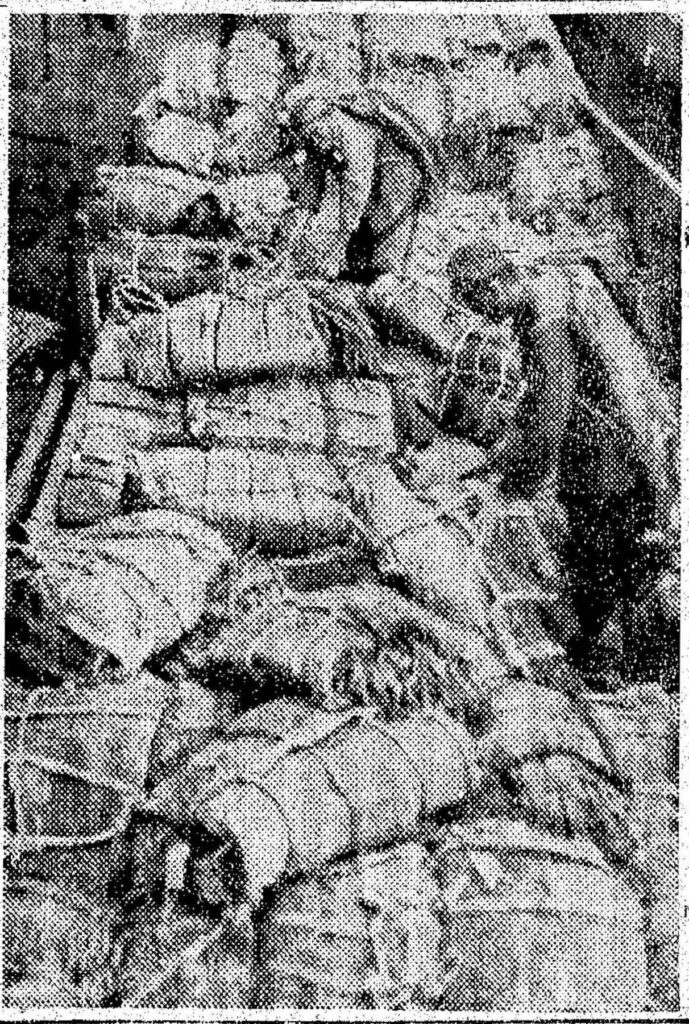
A considerable amount of daikon radishes and bok choy, which had arrived in considerable quantities during the fall and early winter for processing into pickles, has rotted away. This was due to the fact that the vegetable buying teams that were dispatched to the surrounding countryside in the fall brought in a larger quantity than expected, and the efforts by the Seoul government to collect the vegetables were betrayed by the individualistic behavior of the people of Seoul.
The fact that these bok choy and daikon radishes, which arrived at the central market everyday, were left to rot during wartime due to the lack of consumption by the consumers is an indication that it is impossible to simply sum up the situation by using the word “wasteful”.
While there was a huge surplus of these vegetables, there were still households in need of more vegetables for pickling. With these contradictions in mind, the vegetable problem was dealt with by the Seoul Central Fruit and Vegetable Corporation, the receiving agency of the Seoul government under the Korean Fruit and Vegetable Storage Regulations, and in October all vegetables were put under a strong wartime distribution system.
The 560 newly designated vegetable retailers formed blocks for each town council. While maintaining close relations with their own town councils, they began centralized distribution of vegetables to the Patriotic Groups through the town councils.
However, when it came to rationing, the green vegetables were always the same: daikon radish and bok choy, with the occasional small amount of lotus roots and burdock roots. However, carrots, taro roots, and other special vegetables have all but disappeared from rations.
This has caused some controversy, and we asked Mr. Masaji Toya, president of Seoul Central Fruits and Vegetables Corporation, to explain the phenomenon of carrots, burdock roots, yams, and other vegetables making appearances in the public market, albeit being sold openly at horribly high black market prices.
He explained that the rationing of vegetables to retailers is allocated based on the population living in the district to which the retailers belong, so there is no need to worry about the rations being small because of the small number of retailers in certain districts. According to the Patriotic Groups, the vegetables are apparently being rationed equally by household. However, since rationing by the central market to the retailers is done based on population, it is appropriate for the town councils and Patriotic Groups to allocate rations based on the number of families, not based on the number of households.
The shortage of vegetables in general seems to be a problem, but the green vegetables shipments have been rationed at an allocation of 70% for households and 30% for non-home use, and we actually plan on reducing the allotment for non-home use even further. We know that the amount of carrots, burdock roots, tubers, and other vegetables that make it to the kitchens of ordinary people from the retailers is very small due to their very small shipments. But we would like you to endure some shortages with the intention of establishing a wartime lifestyle. We would like the people of Seoul to understand that most of the retailers in town are not selling in the free market, but rather putting all their effort into distributing the vegetables to the Patriotic Groups through the town councils.
It has been said that, the fact that there are special vegetables available at restaurants means that, if we had to distribute these especially scarce special vegetables to 1.2 million households, then the rations would not amount to as much as the tip of a pinky finger. However, if we had a clearly known supply amount of special vegetables along with a good prospect of distributing them to all households, even if it was a little bit, we would be able to distribute the special vegetables in a more orderly fashion. The fact that matsutake mushrooms, which were particularly scarce this fall, were all allocated to restaurant use may have been the cause of the misunderstanding.
In addition, the black market is considerable, and the fact that the market offers a wide range of products at high prices means that undesignated producers from the surrounding areas are appearing in the vicinity of the markets as smugglers, so we have no choice but to wait and see what the economic police authorities will do to crack down on this. The 22 public markets and department stores in Seoul have buffer zones where there is a free market of goods other than those rationed by the town councils. When a given vegetable shipment is small, then those vegetables are not rationed.
Since the introduction of controlled rationing, rations distributed by town councils have not been plentiful, but they have been adequate, and the fact that the vegetables are not distributed to general households is due to the small amount of vegetables arriving at the markets. The market strives to secure 50 to 70 momme (187.5 to 262.5 grams) of vegetables per person per day, and they are receiving close to this amount of vegetables, but there may be some shortages from this time through the winter season.
Regarding the rationing by the retailers to the town councils, when the vegetable shipment is small, free market sales are carried out after discussions with the town council. The first priority is to secure sufficient amounts of vegetables to avoid these free market sales, but shipments of vegetables to the market are getting smaller due to transportation problems and pricing issues.
We asked about the winter supplies of vegetables and future countermeasures….
The Seoul government seems to be working on a concrete plan for the frozen storage of vegetables, but we have no choice but to expect shipments of winter vegetables from producing areas and distribute them according to the amount of vegetables received. To cope with the annual shortage of vegetables from late December to around March, we would like to ask consumers to try to store dried vegetables, such as by splitting and drying daikon radishes which are plentiful in early fall, and storing bok choy tightly wrapped in newspaper sheets in a corner of the kitchen. The market is also doing its best to collect shipments as much as possible. In addition, when shipment amounts are very small, all free market sales will be suspended, and non-home use allocations will be reduced and redirected to general households instead.
Future measures include a registration system to connect traders and consumers, and having town councils take charge of all rationing. Retailers will be strengthened by having them assume full responsibility for rationing. We will carefully select retailers to ensure proper rationing. We are currently conducting a fact-finding survey of designated retailers, and we are readily taking action against those retailers who are of bad character in order to ensure that rationing is strictly enforced.
Regarding fruits, it seems that a few tangerines have been distributed recently for New Year’s Day, and apples have been seen from time to time, but persimmons and other fruits have not been seen at all. Fruits are also distributed by designated retailers through the town councils in the same way as vegetables, but there is almost no supply at all. We will soon receive a considerable amount of apples, but we are trying to collect all the fruit that comes in, even if only a little, as rations for the town councils, so that we can give the fighting residents of Seoul a taste of the four seasons. [Photo: A pile of green onions that have just arrived.]
Source: https://www.archive.org/details/kjnp-1943-12-18
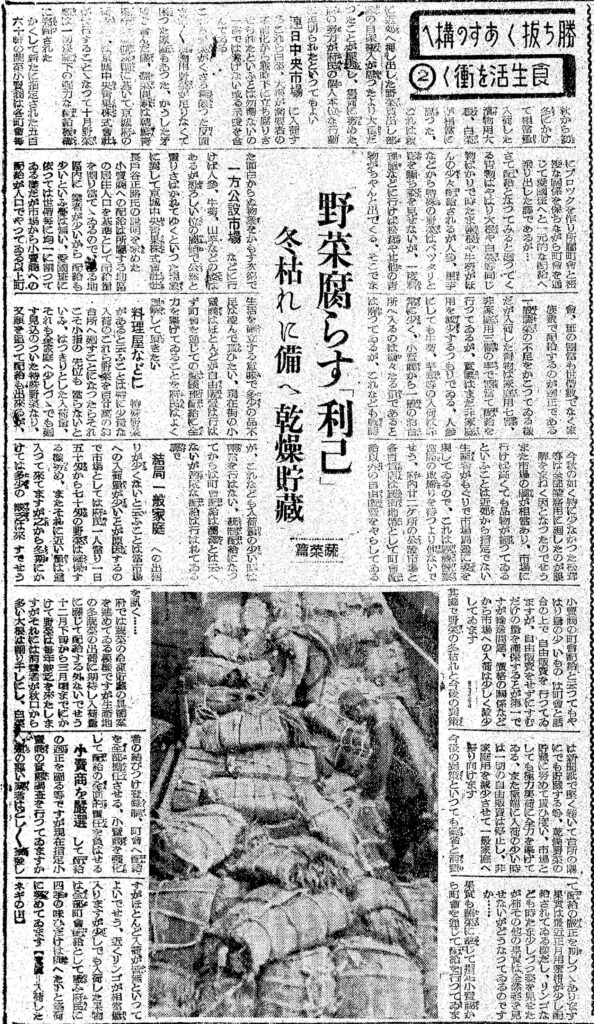
(Transcription)
京城日報 1943年12月18日
野菜腐らす「利己」 蔬菜篇
冬枯れに備え乾燥貯蔵
勝ち抜くあすの構え
食生活を衝く②
秋から初冬にかけて相当量入荷した漬物用大根、白菜が相当に腐った。これは秋に近郊へ押し出した野菜買出し部隊の自家搬入が思ったより大量だったことが原因し、集荷に努めた府の努力が府民の個人本位な行動に裏切られたといってもよい。
連日中央市場に入荷するこれら白菜、大根が需要者の不消化から戦時下に立ち腐りさせられたということは勿体ないの一言では遂げない或る示唆を含んでいる。
これら蔬菜がくさる程余った反面、まだまだ漬物用野菜が足りなくて困った家庭もあった。こうした矛盾を含んだ儘、蔬菜問題は朝鮮青果物貯蔵規制に基いて京城府の荷受機関は京城中央青果株式会社が実行することとなって、十月野菜類は一切決戦下の強力な配給機構に完備された。
かくして新たに指定された五百六十軒の蔬菜小売商は各町会毎にブロックを作り、所属町会と密接な関係を保ちながら町会を通じて愛国班へと一元的な配給へ乗り出した訳であるが、
さて配給となってみると廻ってくる青物はやはり大根や白菜等同じ物ばかりで時たま蓮根や牛蒡(ウマフブキ)がほんの少々配給されるが人参、里芋などから特殊の野菜はバッタリと影を断ち姿を見せないが、一度料理屋などに行けば松茸や其の他の青物がちゃんと出てくる。
そこでまた面白からぬ物議をかもす次第で一方公設市場などに行けば人参、牛蒡、山芋などの姿はあるが、恐ろしい位の闇値で公然と売りさばかれてゆくといった現象に対して京城中央青果株式会社社長戸谷正路氏の説明を求めた。
小売商への配給は所属する地区の居住人口を基準として配給量を割り当てているので、ある地区内に業者が少ないから配給も少ないという憂は無い。愛国班に依っては世帯毎に均一に割っている様だが市場から小売商への配給が人口でやっている以上町会、班の割り当ても世帯数でなく家族数で配給するのが適正である。
一般蔬菜の不足をかこっている様だが入荷した青物は家庭用七割、非家庭用三割の率で割り当て配給を行っているが、実際はまだ非家庭用を減少するつもりである。人参にしても牛蒡、芋類等の入荷は非常に少なく、小売商から一般のお台所へ入るのは微々たる量であることは解っているが、これなども戦時生活を確立する意味で多少の品不足は凌んで貰いたい。現在街の小売商はほとんどが自由販売は行わず町会を通じて愛国班配給に全力を挙げていることを府民はよく理解して頂きたい。
料理屋などに特殊野菜があると云うことは特に少量な入荷のこれら野菜を百二十万のお台所へ廻すことになったら、それこそ小指の先位も当らないという、はっきりとした入荷量、それも全家庭へ少しづつでも廻す見込みのついた特殊野菜なり、又順を追って配給も出来るが、今秋の如く特に少なかった松茸等は全部業務用に廻したのが誤解をまねく因となったのでしょう。
また市場の闇が相当あり、市場に行けば高くても品物が揃っているということは近郊から指定でない生産者がもぐりで市場周辺に姿を現しているので、これは経済警察当局の取締りを待つより他ないでしょう。府内二十二ヶ所の公設市場と各百貨店は緩衝地帯として町会配給以外の自由販売をやらしているが、これなども入荷量の少ない時は割り当てを行わない。
統制配給になってからは町会配給は潤沢とは云えないが、適度な配給は行われている訳で、結局一般家庭への出回りが少なくないと云うことは、当市場への入荷量が少ないことが原因するので、市場としては府民一人当り一日五十匁から七十匁の野菜は確保する様努め、またそれに近い量は這入って来てますが、之から冬期にかけては多少の欠乏は来するでしょう。
小売商の町会配給と云ってもやはり量の少ないものは町会と話し合いの上で自由販売を行っていますが、自由販売をせずにすむだけの量を確保することが第一ですが輸送問題、価格の関係などから市場への入荷は少しく減少しています。
其処で野菜の冬枯れと今後の対策を訊く...
府では蔬菜の冷凍貯蔵の具体案を進めている模様ですが、生産地の冬蔬菜の出荷に期待し、入荷量に応じて配給する外ないでしょう。十二月下旬から三月頃までにかけて野菜は毎年欠乏を来たしますが、それには消費者が秋口から多い大根は割り干しにし、白菜は新聞紙で堅く巻いて台所の隅にでも貯蔵する等、乾燥野菜の貯蔵に努めて貰い度い。市場としても極力集荷に全力を挙げている。また極端に入荷の少ない時は一切の自由販売は停止し、非家庭用を減少させて一般家庭へ振り向けます。
今後の対策といっても業者と消費者の結びつけ登録制、町会へ配給を全部担任させる。小売商を強化して配給の全面的責任を負わせる。小売商を厳選して配給の適正を図る等ですが、現在指定小売商の実態調査を行っていますが、気質の悪い業者はどしどし摘発して配給の厳正を期しつつあります。
果実は最近正月用蜜柑が少し配給されている様だし、リンゴなども時たま少しづつ姿を見せたが、柿その他の果実は全然姿を見せないが、どうなっているのですか?果実も蔬菜に準じて指定小売商から町会を通じて配給を行っていますが、ほとんど入荷が皆無といってよいでしょう。近くリンゴが相当量入りますが、少しでも入荷した果物は全部町会配給として戦う府民に四季の味わいだけは与えたいと集荷に努めています。【写真=入荷したネギの山】
